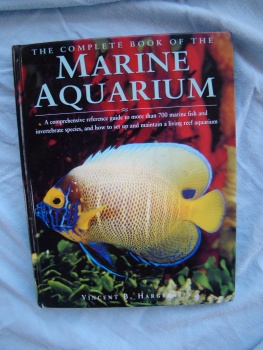
By Bob Goemans

TITLE: The Compete Book of the Marine Aquarium
AUTHOR: Vincent B. Hargreaves
PUBLISHER: Salamander Books Ltd. (U.K.), Thunderbay Press (North America), Interpet Books (Europe) & Heron Books (Australia)
ISBN 1-57145-762-3
PAGES: 304
PRICE: $19.98 (Hardcover)

All would-be aquarists need a good how-to-do-it book so costly errors and loss of animal life do not occur in the process of setting up the new marine aquarium. So do those aquarists that are already into the process and/or are requiring help in solving complex problems arising with the new system, be it their first aquarium or simply another new marine aquarium in their chosen hobby. This book provides just that, as it is well written and illustrated with almost 600 color photographs, numerous illustrations and diagrams, and a comprehensive reference guide to more that 700 marine fish and invertebrate species. Even long-term aquarists and professionals may benefit from reading this excellent writing endeavor.
The work begins with a brief "Introduction" where the author, a marine biologist who is well experienced in Indo-Pacific and Caribbean marine life, discusses his hands-on experience both in the field and in closed systems over the previous four decades. He emphasizes his desire to remove the preconceived and actual complexities and frustrations associated with aquarium keeping, and put aquarium husbandry into an orderly and easily understood process. Once you have read through the entire work, you'll agree with me that he has accomplished his goal.
Following the Introduction, the book is divided into six parts: Part One is titled "The Living Reef In Nature" and contains four subsections: Exploring the deep; Reef communities; Davy Jones's Locker; and, Reef areas of the world (subdivided into the Caribbean, Tropical Indo-Pacific, and the Red Sea areas). All present a concise yet realistic view of the underwater world we marine hobbyists strive to replicate in our closed systems.
Part Two is titled "Establishing A Marine Aquarium" and contains twenty-five subsections: Technical overview; About a reef aquarium; Aquarium sizes and types; Aquarium bases and cabinets; Heating and cooling; Lighting; Water preparation; Bacterial and biochemical reactions; Filtration; Protein skimmers; Ozone reactors; Ultraviolet (UV) sterilizing units; The natural (Berlin) system; The plenum (Jaubert) system; Living rock; Aquarium base media; Decoration and form; Current flow; Maturation times and processes; Water management and control; The next step; Foods and feeding; Symbiosis; General care; and, Some fish diseases. It should go without saying that the information covered in Part Two is extensive, besides something that is not generally seen elsewhere!
Part Three is titled "Aquarium Algae" and consists of four, yet extremely informative subsections: The role of algae; Phylum: Rhodophyta (red algae); Phylum: Heterokontophyta (brown algae); Phylum: Chlorophyta (green algae); and, Higher plants. The photos of these different algae are of exceptional value!
Part Four is titled "Choosing Aquarium Fishes" and contains eight subsections: Scientific classification; Systematics (the fishes); Order: Orectolobiformes; Order: Siluriformes; Order: Syngnathiformes; Order: Scorpaeniformes; Order: Perciformes; and, Order: Tetraodontiformes. All are complete with high quality photos and associated species information.
Part Five is titled "Invertebrates For The Reef Aquarium" and consists of nineteen subsections: The five kingdoms; Kingdom: Animalia; Phylum: Placozoa (trichoplax); Phylum: Porifera (sponges); Phylum: Cnidaria (coelenterates); Phylum: Platyhelminthes (flatworms); Phylum: Gnathostomulida (jaw worms); Phylum: Nemertea (ribbon worms); Phylum: Gastrotricha (hair-bellies); Phylum: Rotifera (rotifers); Phylum: Kinorhyncha (kinorhynchs); Phylum: Annelida (segmented worms); Phylum: Sipunculida (boring worms, peanut worms); Phylum: Arthropoda (joint-legged animals); Phylum: Mollusca (molluscs); Phylum: Phoronida (horseshoe worms); Phylum: Echinodermata (echinoderms); and, Phylum: Chordata (chordates). This portion of the book is a must for all reef hobbyists as it can easily demystify some possible unexplained creatures that may show up in their aquariums!
Part Six is titled "Breeding And Culture Of Fishes And Invertebrates" and is composed of five subsections: The role of the hobbyist; Mariculture; Culture of marine rotifers (Brachionus spp.); Introducing breeding pairs; and, reproduction of reef invertebrates. Another insight rarely seen in most books!
The work closes with a very informative Glossary, a Bibliography, Index, and Acknowledgements.
In conclusion, The Complete Book Of The Marine Aquarium is well-written, extremely informative, beautifully illustrated, and reasonably priced, all making it an excellent addition to your home library. Consider this book your marine 'encyclopedia.'